Last Updated on June 15, 2023 by Grow with Bovees
Azaleas are one of the most popular shrubs in the United States, and with good reason. Their flowers are bright and colorful, and their shrubbery is attractive year-round.
Growing azaleas is one of the most rewarding tasks in the garden, they are the most beautiful shrubs for early spring color.
The range of azalea species includes both evergreens and deciduous. The plants grow quite quickly up to about one meter high, but by trimming them every year after they have finished flowering, they can be kept to a smaller size.
It may not be necessary to trim azaleas for several years since they are slow-growing.
You can grow azaleas both outdoors and in, but, as with many plants, there are some factors to consider when choosing where to plant them.
What Are Good Planting Sites for Azaleas?
The best locations for growing these plants include full sun areas where they will receive adequate light, choose an area where they will receive as much sunlight as possible, at least four hours a day.
They also need good drainage, so water does not sit on their roots. The soil should have plenty of organic matter such as composted manure or leaf mold added at least once every two years.
If you live near in area with heavy clay soil, it is important to add sand or other types of topsoil amendments before adding your plant material.
Shape and Form of Azaleas
There are both deciduous and evergreen varieties of Azaleas.
Most varieties grown in gardens reach a height of between 2 and 6 feet tall (1.83 m) with a similar spread.
They are bushy and usually symmetrical in shape.
Azalea Flowers
The flowers are generally trumpet-shaped with rather slender, elongated corolla tubes, and they appear in small or large clusters at the ends of stems. In some species the flowers are distinctly two-lipped, while in others the petals are frilled at the edges.
The flowering period extends from early winter to mid-spring, and the flowers are to be had in a large variety of shades of every color except blue.
The leaves are, as a rule, narrow and oval or linear and carried in whorls.
Some species have leaves which assume lovely golden to bronze tints in the autumn.
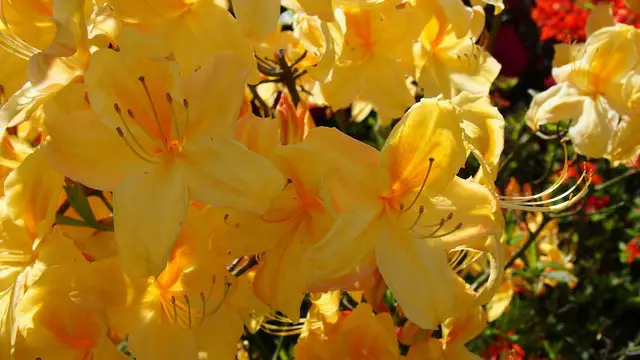
Use of Azaleas
There are probably no flowering shrubs as beautiful as azaleas, and a garden which has little else apart from these and roses is picturesque throughout the year.
Select early, mid-season and late varieties for a blaze of color from late autumn to mid-spring.
When the plants are not in flower, the mass of dark and light green leaves and the pretty shape of the shrubs make them an asset in any garden.
In Europe, they are forced into early bloom to provide flowers during winter, and they are sold to householders in small pots in much the same way as potted hydrangeas.
They may be grown in tubs on the veranda or shady patio as well as in the open garden.
Group them with other acid-loving plants such as hydrangeas, Kalmia latifolia, Vaccinum arboreum, Pieris japonica and camellias.
How To Plant Azaleas
Azaleas have definite preferences as regards soil pH and situation.
If they are provided with the right kind of acidic soil, adequate moisture and partial shade they will thrive, but if they are planted in the wrong kind of soil they will die or remain stunted and refuse to flower.
The soil must be distinctly acid and fairly loose, and they must have an abundance of water particularly from mid-summer to the time when they flower.
In their native haunts they are found growing exposed to full sunshine, but it has been found that really intense sunshine is likely to retard growth and to scorch the flowers, so it is better to plant them in partial shade under deciduous trees.
Hot dry winds are likely to sear the blooms and if such weather prevails during their flowering period they should be sprayed regularly to add humidity to the air about them.
Azaleas are surface-rooting plants and are therefore inclined to suffer if the soil is baked by the sun.
For this reason it is advisable to keep the ground mulched at all times, the layer of mulch being 4-5 in. thick.
A heavy mulch of oak-leaves or fallen pine-needles is of great benefit to them on account of the acidity which the decaying leaves impart to the soil.
The soil in gardens that are not acidic may be amended with soil suitable for placing azaleas in the planting hole.
Dig planting holes about 4 ft (1.22 m) square and 2 ft (0.61 m) in depth and fill the planting hole with well-rotted leaf-mold. Oak leaf-mold is particularly good.
Some nurseries keep a special soil mixture suitable for this purpose. If azaleas are to thrive and provide an abundance of bloom it is absolutely imperative that the soil in which they are planted should be naturally acid or made acid.
Most species of azaleas do best in soils which have a pH value of 4.5 to 5.5.
It must be remembered too, that soils may lose acidity through one cause or another, in the same way as they lose fertility, the heavy mulch layer can help with this.
It may be found that after growing well for a few years the azaleas begin to show signs of being unhappy.
The first sign of this is usually streaks of yellow on the leaves. Since azaleas are long-lived plants it is worth studying their idiosyncrasies and providing them with optimum growing conditions.
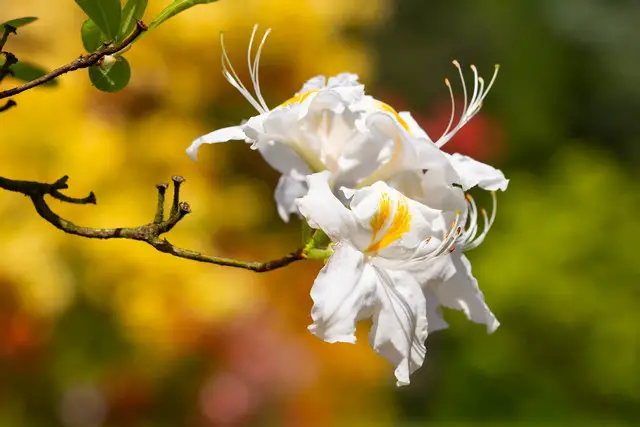
Fertilizing Azalea Shrubs
Azaleas growing in their natural state receive nourishment from decaying vegetable matter which is always present, and it is far better to provide them with nutrients in this way than to try to force them into better growth by applying commercial fertilizers, as most of the ready mixed ones are quite unsuitable.
Well-decayed stable manure may be used, but in applying it, be careful to avoid damaging the surface roots, and fork it only very lightly under the soil.
Azaleas start making flower buds during summer, and it is most essential that soil moisture levels are kept up from this time onwards until bloom time is over.
How To Water Azaleas
Their shallow root systems can easily become parched and shriveled up.
They need plenty of water especially during hot spells, and if you do not give them enough they will wilt and look miserable.
In fact, they cannot stand much drought, so if there is no rain for several days, apply some liquid fertilizer containing nitrogen.
This will help the plant to grow vigorously again.
They grow only in acid soil and should be watered regularly during the dry months of the year.
Because of the dense arrangement of their leaves, overhead irrigation is not recommended as most of the water remains on the leaves, and little penetrates to the roots of the plant.
Soaker hoses or drip irrigation systems are a far better option, and the cost to install a sprinkler system of this kind is far less.
The roots are near the surface and, where it is not practical to water well regularly, it is advisable to mulch the soil with an acid material, such as dropped pine needles or composted oak leaves.
Should the leaves of azaleas show yellowing it is an indication that the soil is not acid enough and the plant should be treated with iron chelates obtainable from plant supply stores.
Azaleas In Pots
If you have azaleas that were purchased in pots, once the potted azaleas have finished flowering, they should either be planted out in the garden or repotted into pots about two sizes bigger than the original ones.
Use a ready-mixed organic potting compost and then add some extra peat to make it more acid.
If the plants are to be kept in pots, you must make sure that they are in a shady place and that they are never allowed to dry out.
Should You Dead Head Azaleas?
Yes, take off the dead flowers.
By removing dead flowers — and the immature seed pods they contain — you encourage the plant to direct its energy into building up strength for the following year rather than into producing seeds, which is what it would do in the wild.
Take care, though, not to damage the young leafy shoots that originate close to the bases of the dead flowers.
Leave the dead flowers and their seed pods on the plant only if you want seed for raising new plants.
Bear in mind, though, that raising azaleas from seed is worthwhile only with true species. Most azalea varieties are hybrids and won’t breed true from seed. If you want seeds, leave only a few pods: more will weaken the parent plant.
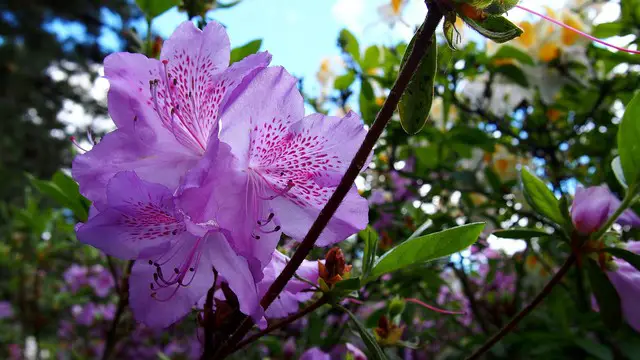
Why Is My Azalea Not Flowering?
Azaleas often fail to flower well if they have been allowed to dry out during the summer months.
This is the time when they set their flowers for the following season and these will not form if the plants become hot and dry.
It is not just a question of keeping the soil damp, as the plants also like a moist atmosphere.
So when watering, use the spray nozzle to spray the foliage as well as the soil surface and, to help keep the plants cool during very dry, hot weather, spray the leaves with water at midday.
What Can I Do About Azalea Leaf Gall?
Azalea gall is a common disease of both deciduous azaleas and evergreen species.
If you look closely at the blobs or swellings, you will see that they are covered with a white, powdery coating.
This is made up of the spores of the fungus which causes the disease. There is no reliable fungicidal treatment, and affected plants soon lose their vigor.
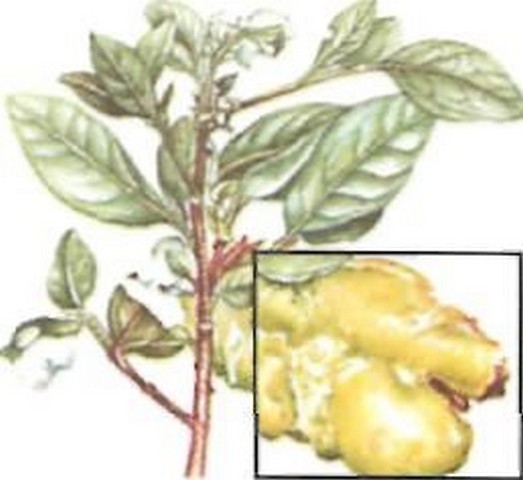
The best antidote against azalea gall is to watch for any signs of an attack and then carefully cut off all the infected shoots and burn them immediately.
You can avoid spreading the disease by dipping your knife or secateurs into a disinfectant such as hydrogen peroxide between cuts and by taking care that you do not disturb the spores.
It may be best to discard the whole plant, as it is probably growing in the wrong soil or position.
Do not plant new azaleas in the same place.
What To Do About Yellow Leaves On Azaleas
Yellow leaves on azaleas and other acid-loving plants are a sure sign that the plant needs nitrogen, as well as increased acid.
Mulch the plants heavily with peat or a special acid azalea compost and an application of nitrogen fertilizer.
If they still remain yellow, they should be sprayed with iron chelate according to the manufacturer’s instructions.
While chelates do not acidify the soil, they liberate nutrients in the soil when absorbed by the plant.
Keep on using chelates until the colour of the new leaves improves.
Aluminum sulphate, sulphate of ammonia, and soil sulfur (flowers of sulfur) are acidifying materials than can be applied to the soil to make it more acid.
The application of an organic mulch will do much to improve the general quality of the soil.
Best Mulch For Azaleas
AAzaleas and rhododendrons are shallow rooted plants, and can suffer badly in dry weather.
A good moisture-retentive mulch for the flower bed is therefore vital to keep the soil moist. Peat is an obvious choice for such acid-loving plants, but only as long as it’s wet.
When it dries out, it forms a crust that can actually throw off excess water.
Shredded or pulverized bark is better. It can be bought in bags or in bulk.
Don’t be tempted to buy bargain lots of cheap unbranded bark. It may not have been properly composted and could still contain toxic residues.
One of the cheapest mulches is pine needles, which you can collect for nothing in forests — provided, of course, that you have permission or a permit to do so.
A thick mulch of well-rotted compost is always beneficial.
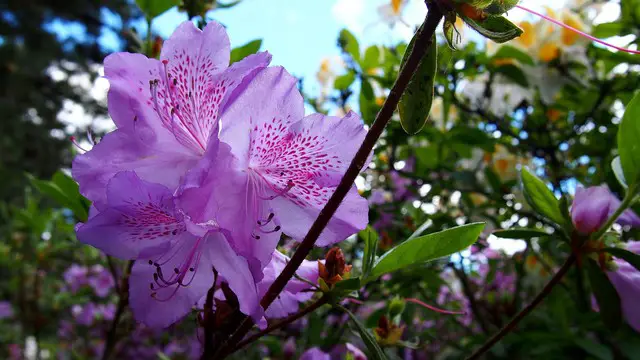
If Your Azaleas Are Fading Over Time
It could be one or more of three things.
To start with, your garden soil may not suit the plants as well as the acidic compost of the containers in which you bought them. If that’s so, the azaleas root growth won’t extend beyond the confines of the compost.
And if that happens, the nutrients in the compost will keep the plants going for the first year or two, but after that they’ll starve.
If you think the soil is the problem, there are two solutions.
First, when removing the azalea — or indeed any plant from its container — gently tease the roots out around the edge to encourage them to grow out into the soil.
Be very careful as any damage to the roots will serve to kill the plant.
Second, enrich the soil in which the plant is being placed with acid compost.
Many nurseries sell special acid azalea compost just for this purpose.
Don’t use bone meal — it’s too alkaline for such an acid-loving plant.
Another possible reason for the decline of your plants may be the site. Although azaleas are plants of sheltered, damp woodland, they won’t tolerate a waterlogged, compacted soil. Neither will they do well in a windswept, exposed, dry position.
Make sure the plants are in a cool, sheltered, position with light shade. When preparing the site, dig in plenty of bulky organic material, such as compost, peat or bark. This will ensure that the soil retains moisture but does not become waterlogged.
The third reason why your azaleas may be growing badly is the depth at which you’re planting them.
Azaleas and rhododendrons are surface-rooting and do not like being buried deeply.
With a new plant, take care not to set it any deeper than the existing soil mark on its stem.
An ailing plant that’s already in the ground can sometimes be revived by digging it up, dressing the roots with fertilizer and replanting it in a more shallow position.
An important rule to follow is never to dig around azaleas, as this will damage the roots which lie close to the surface.
Remove weeds by hand and keep the surface mulched with a thick layer of compost or pine needles to prevent weed growth and keep in moisture.
How Do I Lower the Soil pH for Azaleas and Rhododendrons?
The easiest way to lower the soil pH is by using sulfuric acid.
Sulfuric acid lowers the soil pH because it reacts chemically with iron ions present in clay minerals found in sandy loam soils. This reaction causes an increase in soluble aluminum, which then leaches into the surrounding water table.
When applied at rates greater than 1 pound per 100 square feet, sulfuric acid will reduce the soil pH below 5.0 within one year.
How To Propagate Azaleas
There are three ways — by seed, by cuttings, and by layering.
Growing From Seed
Raising azaleas from seed is a lengthy business and, unless you are interested in producing hybrid azaleas, worthwhile only with the few, true species.
Propagate Azaleas From Cuttings
Reproduction by cuttings is easy and much quicker.
Take cuttings in late summer when the new wood is semi-ripe: when it can be bent over, but will not snap until it’s been bent almost double.
Cut lengths of healthy shoots about 3 inches (7.62 cm) long and trim away the lower leaves.
As a rooting medium, mix an equal amount by volume of peat moss and river sand.
Spread the mixture in a container to which a more-or-less airtight translucent cover can be fitted — a flowerpot with a plastic bag tied over it will do.
Dip the base of each cutting into a hormone rooting powder, and push it gently into the rooting medium.
Seal the container and stand it in a well-lit spot out of direct sunlight — a greenhouse or shade house would be ideal.
Most azaleas will root within about three months.
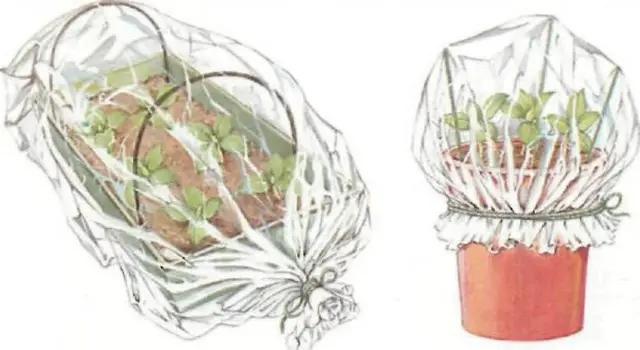
Clear or milky plastic bags make good propagating cases for azaleas and for any other small cuttings or seeds.
One way is to up-end a bag over a pot; another is to put the pot or tray right inside the bag and blow the bag up. Support it, if necessary, with wire hoops made from old coat hangers and seal the opening with a freezer tie.
Propagation By Layering
Layering also works well and is the easiest method of all.
Simply select a low-growing shoot or branch and anchor it into the soil with a small wooden peg held down with stones.
Remember where you made the layer, for it may take up to two years to root.
When it has rooted, sever it cleanly from the parent and treat it like a separate plant.
Azalea Varieties
There are many types of azaleas which have been hybridized from species indigenous to Asia, China, Japan and the United States of America.
Some of these species are deciduous while others remain evergreen. Generally speaking, the evergreen azaleas are able to stand higher temperatures, while the deciduous types will grow under freezing conditions.
Evergreen Azaleas
Evergreens do not lose their leaves during winter; instead they remain green throughout the year. They may look bare until the first frosts begin to arrive.
They usually grow well in shade and make excellent ground cover plants.
Azaleas suitable for planting out in gardens are often called ‘hardy’ azaleas because they tolerate cold winters better than most other types of plant. However, there are many exceptions, especially if you live somewhere where temperatures drop below -10°C
Azalea indica
This variety has been bred from a group of native azaleas from southern Asia, and it grows very well in many areas wherever the right conditions as to soil and humidity are provided.
The flowers are large, sometimes single and sometimes double, and they may be white, pink, rose, mauve, magenta, crimson, salmon or flame in colour.
This particular variety does not like extremes of cold. The ones with white or magenta flowers are the hardiest and grow much more quickly and into larger bushes than the others.
They flower from autumn to early spring.

Kurume azaleas
Dr. Wilson, a renowned plant collector who was passionately fond of azaleas, said, when he discovered these growing in Japan: ‘I think that Kurume azaleas are the loveliest of all azaleas.’
The flowers of this group are smaller than those of the indica group, but they are borne in greater quantities. Shrubs in full bloom are sometimes so covered with flowers that the leaves cannot be seen.
The colours include white, pink, rose, scarlet, salmon and palest mauve. Many of them have flowers which are tinted and shaded.
The Kurumes are hardier than the indica azaleas and a healthy plant is less likely to be damaged by severe frost followed by hot days.
Macrantha azaleas are low, spreading shrubs with attractive foliage and flowers which are single or double, pale pink, mauve, salmon, red or white. The flowers open in late autumn and the bloom period continues right through to early spring.
The following are the names of some good Macrantha varieties:
- Beni-Kirin (blood-red)
- Fuginishiki (variegated white flowers with lavender lines)
- Gumpo (white flowers)
- Izayoi (flesh-pink flowers)
- Macrantha (double pink flowers)
- Okinanishiki (orange-red
- Sakuragata (dark crimson)
- Wakamatsue (mauve)
Deciduous Varieties of Azaleas
These azaleas bloom later than the evergreen species, but the leaves turn to brilliant colors before dropping in the autumn, and they can endure freezing conditions.
If different species are planted, they will produce flowers for a long period.
Among the best known of the deciduous azaleas are the following:
Ghent hybrids.
Nurserymen in Belgium were ardent collectors of azaleas particularly at the beginning of the nineteenth century, and it is to the hybridizing work of some of these nurserymen of Ghent that we owe some of the finest azaleas now cultivated.
These hybrids were the result of crossing an Asiatic strain with an American species.
The autumn tints of their leaves are very striking and the wide, tubular, scented flowers appear at the same time as the new leaves.
This group is outstanding in the variety of colour of the flowers—white, lemon, canary, yellow, orange, copper, bronze, pink, rose, crimson, red, scarlet, mauve and purple.
Mollis azaleas
These come into flower earlier than the Ghent hybrid and are in full bloom before the leaves develop.
The blooms are magnificent in colour, from pale gold to rich orange, yellow, salmon, apricot, pink and deep crimson.
Kaempfer hybrids
These have flowers of striking shades of orange, pink and red.
They are extremely hardy, but the blooms are apt to fade in strong sunlight and they should therefore always be planted in a shady spot in the garden.
How To Prune Azaleas
Please see our article on azalea pruning by clicking the text above.
